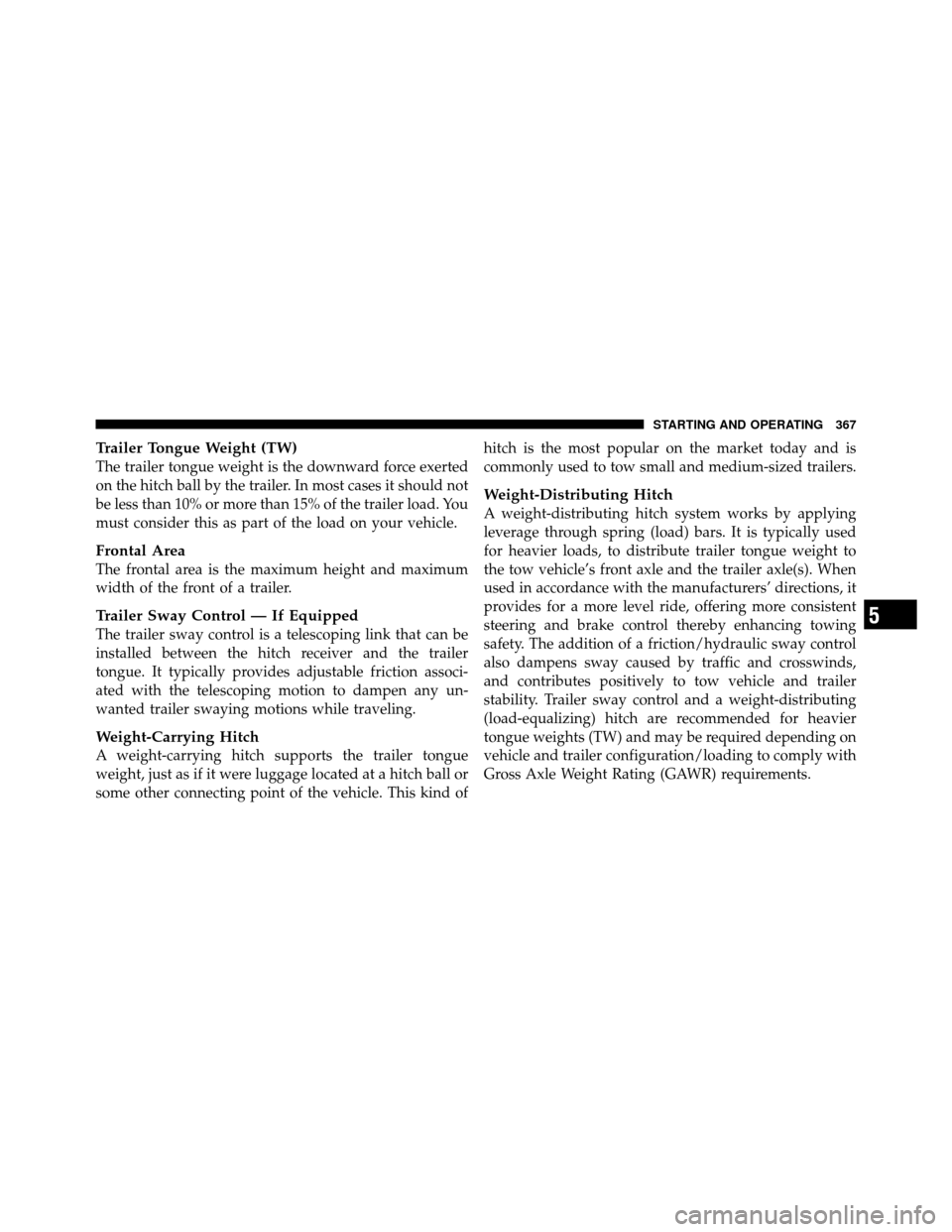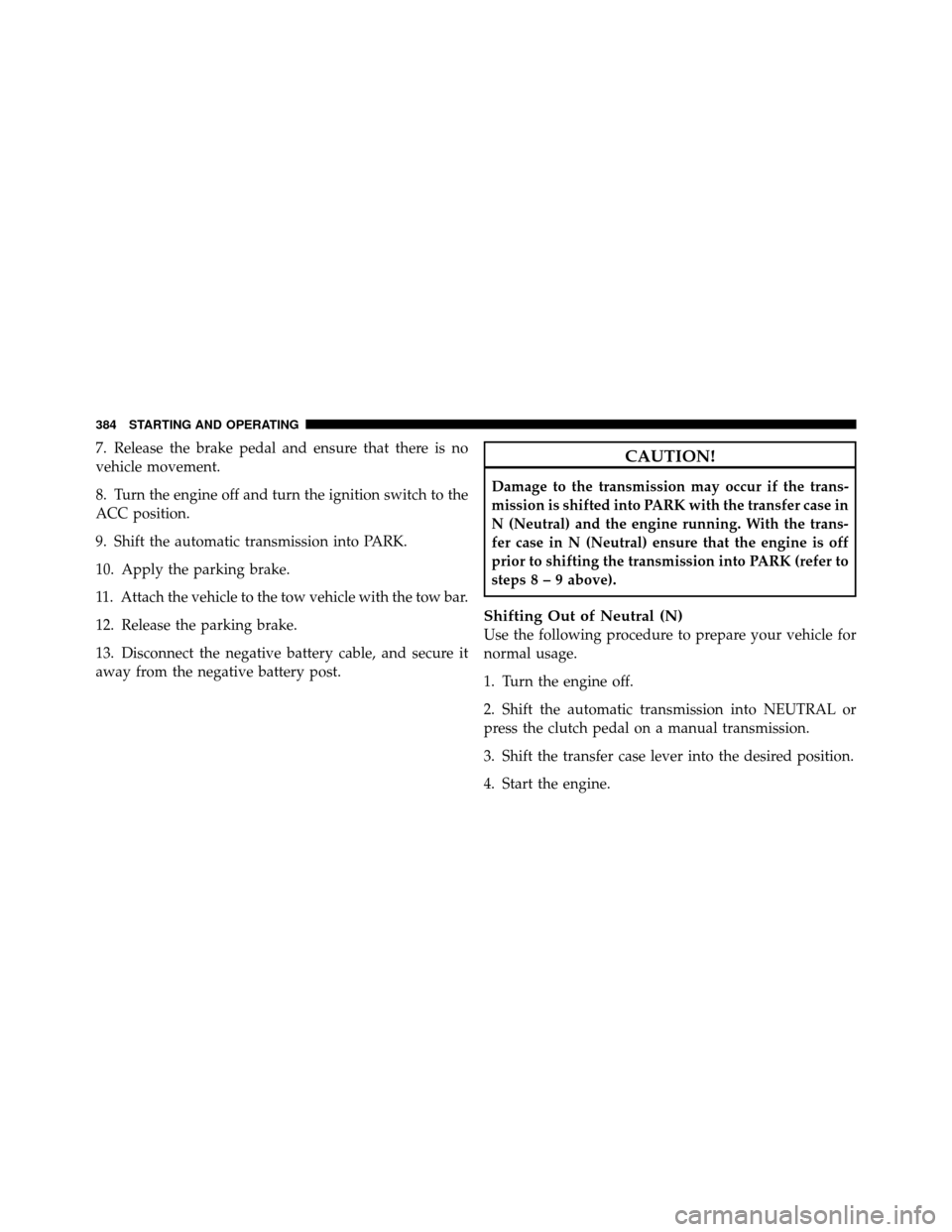tow bar JEEP WRANGLER 2009 JK / 3.G Owners Manual
[x] Cancel search | Manufacturer: JEEP, Model Year: 2009, Model line: WRANGLER, Model: JEEP WRANGLER 2009 JK / 3.GPages: 502, PDF Size: 14.47 MB
Page 369 of 502

Trailer Tongue Weight (TW)
The trailer tongue weight is the downward force exerted
on the hitch ball by the trailer. In most cases it should not
be less than 10% or more than 15% of the trailer load. You
must consider this as part of the load on your vehicle.
Frontal Area
The frontal area is the maximum height and maximum
width of the front of a trailer.
Trailer Sway Control — If Equipped
The trailer sway control is a telescoping link that can be
installed between the hitch receiver and the trailer
tongue. It typically provides adjustable friction associ-
ated with the telescoping motion to dampen any un-
wanted trailer swaying motions while traveling.
Weight-Carrying Hitch
A weight-carrying hitch supports the trailer tongue
weight, just as if it were luggage located at a hitch ball or
some other connecting point of the vehicle. This kind ofhitch is the most popular on the market today and is
commonly used to tow small and medium-sized trailers.
Weight-Distributing Hitch
A weight-distributing hitch system works by applying
leverage through spring (load) bars. It is typically used
for heavier loads, to distribute trailer tongue weight to
the tow vehicle’s front axle and the trailer axle(s). When
used in accordance with the manufacturers’ directions, it
provides for a more level ride, offering more consistent
steering and brake control thereby enhancing towing
safety. The addition of a friction/hydraulic sway control
also dampens sway caused by traffic and crosswinds,
and contributes positively to tow vehicle and trailer
stability. Trailer sway control and a weight-distributing
(load-equalizing) hitch are recommended for heavier
tongue weights (TW) and may be required depending on
vehicle and trailer configuration/loading to comply with
Gross Axle Weight Rating (GAWR) requirements.
5
STARTING AND OPERATING 367
Page 386 of 502

7. Release the brake pedal and ensure that there is no
vehicle movement.
8. Turn the engine off and turn the ignition switch to the
ACC position.
9. Shift the automatic transmission into PARK.
10. Apply the parking brake.
11. Attach the vehicle to the tow vehicle with the tow bar.
12. Release the parking brake.
13. Disconnect the negative battery cable, and secure it
away from the negative battery post.CAUTION!
Damage to the transmission may occur if the trans-
mission is shifted into PARK with the transfer case in
N (Neutral) and the engine running. With the trans-
fer case in N (Neutral) ensure that the engine is off
prior to shifting the transmission into PARK (refer to
steps8–9above).
Shifting Out of Neutral (N)
Use the following procedure to prepare your vehicle for
normal usage.
1. Turn the engine off.
2. Shift the automatic transmission into NEUTRAL or
press the clutch pedal on a manual transmission.
3. Shift the transfer case lever into the desired position.
4. Start the engine.
384 STARTING AND OPERATING
Page 387 of 502

5. Shift the automatic transmission into DRIVE or release
the clutch on manual transmissions.
NOTE:When shifting out of transfer case N (Neutral)
on automatic transmission-equipped vehicles, turning
the engine off may be required to avoid gear clash.CAUTION!
•Do not use a bumper-mounted clamp-on tow bar
on your vehicle. The bumper face bar will be
damaged.
5
STARTING AND OPERATING 385